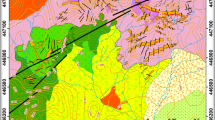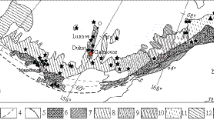Abstract
The Tikhoe epithermal deposit is located in the Okhotsk–Chukotka volcanic belt (OChVB) 250 km northeast of Magadan. Like other deposits belonging to the Ivan’insky volcanic–plutonic depression (VTD), the Tikhoe deposit is characterized by high-grade Au–Ag ore with an average Au grade of 23.13 gpt Au and Au/Ag ratio varying from 1: 1 to 1: 10. The detailed explored Tikhoe-1 orebody is accompanied by a thick (20 m) aureole of argillic alteration. Pyrite is predominant among ore minerals; galena, arsenopyrite, sphalerite, Ag sulfosalts, fahlore, electrum, and küstelite are less abundant. The ore is characterized by abundant Sebearing minerals. Cu–As geochemical specialization is noted for silver minerals. Elevated Se and Fe molar fractions of the main ore minerals are caused by their formation in the near-surface argillic alteration zone. The veins and veinlets of the Tikhoe-1 ore zone formed stepwise at a temperature of 230 to 105°C from Nachloride solution enriched in Mg and Ca cations with increasing salinity. The parameters of the ore-forming fluid correspond to those of epithermal low-sulfidation deposits and assume the formation of high-grade ore under a screening unit of volcanic rocks. In general, the composition of the ore-forming fluid fits the mineralogy and geochemistry of ore at this deposit. The similarity of the ore composition and parameters of the ore-forming fluid between the Tikhoe and Julietta deposits is noteworthy. Meanwhile, differences are mainly related to the lower temperature and fluid salinity at the Julietta deposit with respect to the Tikhoe deposit. The fluid at the Julietta deposit is depleted in most components compared with that at the Tikhoe deposit except for Sb, Cd, and Ag. The results testify to a different erosion level at the deposits as derivatives of the same ore-forming system. The large scale of the latter allows us to predict the discovery of new high-grade objects, including hidden mineralization, which is not exposed at the ore field flanks and beyond them.
Similar content being viewed by others
References
Bodnar, R.J. and Vityk, M.O., Interpretation of microterhrmometric data for H2O–NaCl fluid inclusions, Fluid Inclusions in Minerals: Methods and Applications, Siena: Pontignano, 1994, pp. 117–130.
Borisenko, A.S., Cryometric study of salt composition of gas–liquid inclusions in minerals, Geol. Geofiz., 1977, no. 8, pp. 16–27.
Bortnikov, N.S., Genkin, A.D., and Kovalenker, V.A., Mineralogical–geochemical indicators of conditions of hydrothermal ore formation, in Endogennye rudnye raiony i mestorozhdeniya (Endogenic Ore Districts and Deposits), Moscow: Nauka, 1987, p. 40.
Brown, P., Flincor: a computer program for the reduction and investigation of fluid inclusion data, Am. Mineral., 1989, vol. 74, pp. 1390–1393.
Danilin, M.V., Mineralogical zoning—criteria of hidden gold–silver mineralization of the Ivan’inskoe ore cluster (Magadan region’), Rudy Met., 2011, no. 3–4, pp. 54–55.
Hedenquist, J.W., Arribas, A., and Gonzalez–Urien, E., Exploration for epithermal gold deposits, in Gold in 2000, SEG Shortcourse, 2000, vol. 13, pp. 245–277.
Kovalenker, V.A., Structural and mineralogical–geochemical zoning of epithermal deposits as basis for the prediction assessment of deep horizons, in Sovremennye problemy geologii i razvitiya mineral’no–syr’evoi bazy Respubliki Uzbekistan (Modern Problems of Geology and Development of Raw Mineral Base of Uzbekistan Republic), Tashkent: IMR, 2007, pp. 84–86.
Kovalenker, V.A. and Plotinskaya, O.Yu., Mineral assemblages of Cu–Sn–sulfides as indicators of Hs–Is transition in epithermal environment, Acta Mineral.–Petrogr., Abstr. Ser., 2010, vol. 6, p. 225.
Kryazhev, S.G., Prokof’ev, V.Yu., and Vasyuta, Yu.V., Application of ICP MSin analyzing ore–forming fluid, Vestn. Mosk. Gos, Univ., Ser. Geol., 2006, no. 4, pp. 30–36.
Obushkov, A.V., Struzhkov, S.F., Natalenko, M.V., et al., Geology and mineralogy of ore at the hidden Engteri Au–Ag deposit, the Magadan Region, Geol. Ore Deposits, 2010, vol. 52, no. 6, pp. 459–478.
Prokof’ev, V.Yu., Ali, A.A., Volkov, A.V., et al., Geochemical peculiarities of ore–forming fluid of the Juliette Au–Ag epithermal deposit (Northeastern Russia), Dokl. Earth Sci., 2015, vol. 460, no. 1, pp. 87–91.
Roedder, E., Fluid Inclusions. Rev. Mineral., 1984, vol. 12.
Ryzhov, O.B., Struzhkov, S.F., Aristov, V.V., et al., Geological structure and composition of ores of the Juliette gold–silver deposit (Northeast Russia), Rudy Met., 1995, no. 2, pp. 66–78.
Savva, N.E. and Fidrya, I.L., Reflection of regional metallogenic featyres of territory in the mineralogical–geochemical specialization of ores of the Juliette gold–silver deposit, in Mineralogiya i geneticheskie osobennosti mestorozhdenii zolota i serebra (Mineralogy and Genetic Features of Gold and Silver Deposits), Magadan: SVKNII, 1996, pp. 119–130.
Savva, N.E., Pal’yanova, G.A., and Byankin, M.A., The problem of genesis of gold and silver sufides and selenides in the Kupol deposit (Chikchi Peninsula, Russia), Russ Geol. Geophys., 2012, vol. 53, no. 3, pp. 457–466.
Sidorov, A.A., Zoloto–serebryanaya formatsiya Vostochno–Aziatskikh vulkanogennykh poyasov (Gold–Silver Formation of the East Asian Volcanogenic Belts), Magadan: SVKNII, 1978.
Sidorov, A.A., Belyi, V.F., Volkov, A.V., et al., The gold–silver Okhotsk–Chukotka volcanic belt, Geol. Ore Deposits, 2009, vol. 51, no. 6, pp. 441–455.
Strujkov, S.F., Ryjov, O.B., Aristov, V.V., et al., Geological structure and ore mineralogy of the Julietta gold–silver deposit, Northeast Russia, Int. Geol. Rev., 1996, vol. 38, pp. 625–648.
Struzhkov, S.F. and Konstantinov, M.M., Metallogeniya zolota i serebra Okhotsko–Chukotskogo vulkanogennogo poyasa (Gold and Silver Metallogeny of the Okotsk–Chukotka Voclanogenic Belt), Moscow: Nauchnyi mir, 2005.
Volkov, A.V., Prokof’ev, V.Yu., Savva, N.E., et al., Ore formation at the Kupol epithermal gold–silver deposit in Northeastern Russia deduced from fluid inclusion study, Geol. Ore Deposits, 2012, vol. 54, no. 4, pp. 295–303.
Volkov, A.V., Prokof’ev, V.Yu., Ali, A.A., et al., Peculiarities of ore formation at the N’yavlenga Au–Ag epithermal deposit, Northeast Russia, Dokl. Earth Sci., 2014, vol. 458, no. 3, pp. 10063–1066.
Yuningsih, E.T., Matsueda, H., and Rosana, M.F., Epithermal gold–silver deposits in Western Java, Indonesia: gold–silver selenide–telluride mineralization, Indones. J. Geosci., 2014, vol. 1, no. 2, pp. 71–81.
Author information
Authors and Affiliations
Corresponding author
Additional information
Original Russian Text © A.V. Volkov, E.E. Kolova, N.E. Savva, A.A. Sidorov, V.Yu. Prokof’ev, A.A. Ali, 2016, published in Geologiya Rudnykh Mestorozhdenii, 2016, Vol. 58, No. 5, pp. 476–491.
Rights and permissions
About this article
Cite this article
Volkov, A.V., Kolova, E.E., Savva, N.E. et al. Formation conditions of high-grade gold–silver ore of epithermal Tikhoe deposit, Russian Northeast. Geol. Ore Deposits 58, 427–441 (2016). https://doi.org/10.1134/S107570151605007X
Received:
Published:
Issue Date:
DOI: https://doi.org/10.1134/S107570151605007X




